Band Of Holy Joy - Interview
by John Clarkson
published: 23 / 10 / 2015
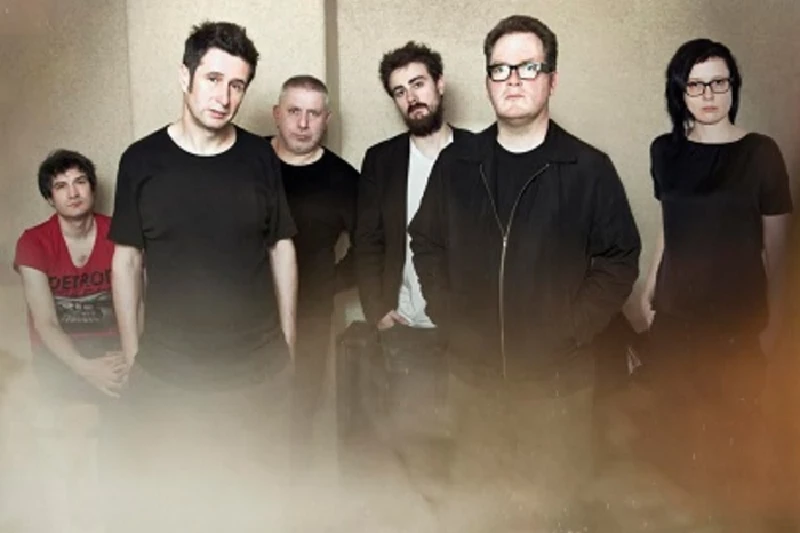
intro
John Clarkson speaks to Johny Brown, Inga Tillere and James Stephen Finn from London-based alternative rock band the Band of Holy Joy about the making of their band's latest album, 'The Land of Holy Joy'.
“I live here. I have lived here for thirty years,” says Johny Brown. “My band lives here. All my friends are here. I love London. I have committed more than half my life to this city. Why should I be pushed out?” Yet being “pushed out” is an issue that is afflicting an increasing number of Londoners. As house and rental prices escalate, as the super-rich descend on it and once working class districts are regentrified, more and more native Londoners are being forced out into the provinces, no longer able to afford to live there. Brown is talking to Pennyblackmusic a few days before its release about his group, the Band of Holy Joy’s nineteenth album, ‘The Land of Holy Joy’, or, to give it its extended title, ‘ A Night of Word and Blood Sparked under Fire and Stars a Petrol Smear the Concrete Tear Fuck Yeah Brutalism Still Dreaming in the Land of Holy Joy’. His adopted city is the dominant theme of the character-driven ‘The Land of Holy Joy’; its changing terrain and landscape, and how it has got itself into such a catastrophic mess that a large proportion of its occupants are no longer able to stay there. Brown, who has also written several radio and theatre plays, has created a nightmarish, dystopian Ballard-esque vision of the capital city in ‘The Land of Holy Joy’, of child sex rings in high offices and in which teenagers are stabbed to death on buses and refugees are forced into prostitution. Yet for all this ‘The Land of Holy Joy’, which has been released on the Edinburgh-based label Stereogram Recordings (The Cathode Ray, Roy Moller, James King and the Lonewolves) is an album about quiet triumph, of finding reasons for carrying on often against huge odds. On the opening title track, which emerges skittering Ethiopian beats with soaring electronica and guitars, its protagonist, wearying of the city and its sleaze, heads back to nature and out to the countryside. At first he finds it to be equally depressing – the sea is grey with dirt and pollution – but eventually he discovers what he is looking for in a quiet woodland on a starry night (“Oh peace of mind and now begin to see/The man I was and the man I can be”). The female narrator on the chiming indie pop of ‘Isn’t That Just Life’ has long accepted that the only way she can beat life is by being harder than anything which it throws at her. A tattoo, which she had engrained on her pelvis many years ago, serves for her as a symbol of hope (“A fragile stem topped by a simple blue flower/It has been me with through the darkest of darkening hours”). The this time male narrator of the funk-ridden post-punk of ’Men Who Display a Different Kind of Pain’ wants to put behind his violent criminal past for his new love. ‘Discredited Art Form’ succeeds the album’s middle and most turbulent track, the discordant ‘Violent Drunken Strangers’, and, setting a spoken word narrative from Brown against a light lounge jazz number, is offbeat and gorily comic, telling of a writer who gets too close to his subject matter (“The next thing I knew I had woken up in A and E with both eyes missing”). The last track on the nine-song ‘The Land of Holy Joy’ is ‘I’m Crass Harry’, which finishes in a riotous fusion of guitars, keyboards and saxophone, and tells of it title character, an elderly Londoner and ex-punk, who, despite being abused by a succession of powers – the police, the medical services and the Greater London Council – and winding up in a care home, never loses his spirit or sense of optimism (“I’m living proof of those who live in hope/Whose spirit just won’t get broke”). First formed in a squat in New Cross in 1984, shortly after Brown moved from his native North Shields to London as a twenty year old, the Band of Holy Joy has seen approximately forty members pass through its ranks over the years of which Brown and drummer William J. Lewington are the sole surviving members. It has, however, become increasingly multimedia-based with the induction of Brown’s long-term girlfriend, the Latvian-born Inga Tillere, into the group, who provides the band’s artwork, on-stage visuals and has directed and filmed all of its promo videos in recent years. The Band of Holy Joy has for the last thirteen years also run a succession of radio programmes on the experimental London-based art station Resonance FM, the latest of which is ‘Bad Punk’. The line-up of the Band of Holy Joy for ‘The Land of Holy Joy’ also consisted, as well as Brown, Lewington and Tillere, of James Stephen Finn (guitars); Mark Beazley (bass) and Peter Smith (saxophones and keyboards). Pennyblackmusic spoke to Johny Brown, Inga Tillere and long-term guitarist James Stephen Finn about ‘The Land of Holy Joy’. PB: You were originally going to call the new album ‘Weird Tales’. Why did you decide to change its name to ‘The Land of Holy Joy’? JB: It seemed more appropriate to the lyrics. The lyrics on the album involve lots of different characters, who are all displaced and trying to find themselves in Britain at this moment in time. The whole album is written from an outsider’s point of view. I have also developed from touring around Britain a love of Brutalist architecture and buildings. The long title, I think, in particular represents all of that. PB: You create in your lyrics on it a dystopian view of the world. Some might see that as portraying a very pessimistic view of society, yet the main theme of ‘The Land of Holy Joy ‘ seems to be about finding hope against the odds. JB: Definitely. It is a really optimistic album. The last track ‘Crass Harry’ deliberately ends on a real high for that reason. PB: Yet Harry goes through hell to reach that high. He is beaten up by the police after being wrongfully arrested, and finds he has got cancer after going for what he thinks is a routine GP appointment. He is then thrown out of his family home of generations, before finally ending up in a care home. Did anyone in particular inspire that story? JB: It is just a story. It is about an old Londoner who doesn’t really understand what is happening around him. Most of the songs on the album are about people who are hanging onto a London that is changing. You hear and see stories like that every day in London. I see it at work. I see it through working on the radio station. I see it through my friends. I see it through the prices in my street that have quadrupled since we moved in to this flat in which we live in. You see it all around you and the changes are pretty intense. PB: Inga, the front cover shows sheep grazing against the backdrop of an apocalyptic-looking city. What inspired you to put that particular image on the front sleeve? IT: I like to create photomontages of non-existent places and time. Having ‘The Land of Holy Joy’ as a title, similarly to our 2012 album ‘The North is Another Land’, practically invited that sort of approach. Photography in itself has the ability to freeze time, seen from a particular viewpoint, in certain light, capturing moments often unnoticed by the human eye. Something that happened only for a fracture of a second and will never happen again and to a degree makes you wonder did it ever, blurring the boundaries between the reality and the unreal. I take this arbitrary boundary a step further. The metaphysical landscape appears real enough to evoke narratives referenced in Johny’s lyrics that are very much about the changing landscape that surrounds us now, quite possibly, falling into ruin. PB: On the back sleeve there is another image with the sheep grazing but this time against the backdrop of a farmhouse at night. Why did you decide to put that image there? Were you trying with these juxtaposing images to show the contrast between the way the world now is and the more tranquil image of the way the world should be and once was? IT: I think it is more about the continuous cycle that exists between urban and rural environments – this simultaneous magnetism and repugnance. Cities encapsulate allure, energy, a promise of one sort or another, a continuous search, a melting pot of ideas… all of which draws people in – even now, despite the ludicrously high living costs, more and more people are flocking to London. And yet, at the same time, increasing numbers are leaving or are driven out, sometimes choosing rural life as an alternative to city living. Is the romanticized country life better than the glitzy sugar rush afforded by the metropolis? Is one a more natural way of living than the other? Is it ever that simple? Meanwhile the cycle and the dreaming go on. PB: ‘The Land of Holy Joy’ was recorded in Slowfoot Studios rather than your regular base of One Cat Studios. Why did you decide to shift there, James? What do you think working at Slow Foot brought to the recording? JSF: Working at One Cat Studios with Jon Clayton, who runs it, has always been a comfortable and productive experience. Jon knows how we work. He's very quick and has a real good ear for music. This is a band that’s constantly changing though. We're always wanting to explore new musical ideas, to keep progressing and getting better as musicians. Sometimes adding somebody new into the group can bring along something fresh, another perspective or interpretation of how you could shape your songs. Having worked with Jon on all of our releases since 2011 it interested us to see what Frank Byng, who owns Slow Foot and who co-produced this album, would throw into the pot. It was initially a difficult decision to make as there are so many advantages to working with Jon at One Cat, but it was ultimately scheduling that finalised that decision. Jon Clayton, however, still had some influence in the making of this record as three of its songs had been previously recorded with him at One Cat Studios. It made the process with Frank Byng all the more quicker as with 'The Land of Holy Joy' and 'A Place Called Home' we already knew what we wanted from those tracks. 'Violent Drunken Strangers' was one that Jon helped to conceive. That was one which came together during our sessions for our 2013 album, 'City of Tales: Volume 2'. The new band version of that song has developed considerably, but a lot of those original ideas are still there. PB: What do you think Frank Byng brought to the album? JSF: Frank Byng is really a very patient and hardworking person. It gives you confidence to put your songs in the hands of somebody who cares, likes what you're doing and really puts in the shifts to ensure quality. Frank seemed to fit really well within the collaborative form that we like our recording sessions to take. Not so much taking control, but working with us, giving honest and critical feedback where necessary and inputting his own creative, and at times conceptual, ideas. These included quite intricate additions, which we particularly love, those little details which happen only once, or subtly, or in specific places or contexts to help to keep things interesting. That input is particularly noticeable when you listen to how the vocals are treated throughout the record. It was definitely a collaborative effort. PB: The album is listed as having Tim Melia as “executive producer”. What did his role involve? JSF: Tim Melia has been an extended member of Holy Joy family longer than I've been a part of the band. He's seen it in its various incarnations. While he assisted with the more logistical side of the recording, it was great to have him in the studio for part of the recording process too and to have the opinion and reaction of somebody who's very familiar the band's music and history. I remember one session in particular where we were getting backing vocals down, so the studio was really busy. Tim was there, along with Anne Gilpin and Robert Jessett from Morton Valence, and Simon Rivers from the Bitter Springs. There was a very positive vibe about what we were doing that day which was encouraging. It helps you to keep perspective, getting feedback from people who haven't spent as much time with those songs as you have and who can add something fresh to the mix. Johny is incredibly good at keeping that energy up in the studio. He always has a vision and the positivity and faith he has in the songs and musicians really motivates some creative performances out of everyone involved. PB: Johny, you have changed the lyrics that were on the digital single version of the title track and put in their place different ones for the album. The lyrics on the digital single were darkly funny, finding the narrator trying to escape the grind of the city for the quiet of the country but realising it is all too calm for him and not really what he was looking for at all. On the album, however, he finds a greater “peace of mind” there than in the city. Why did you decide to change the lyrics for the album version? # JB: I just wanted to set the scene and to lay out the terrain for the rest of the album. It is the first song on the album, and I wanted it to set out the landscape and tap into that idea of finding hope where there is hope from the outset. PB: On ‘Isn’t That Just the Life’ you write from the viewpoint of a woman. JB: While it is written from a woman’s point of view, it is written from my point of view too. It is about someone realising that it is a tough world, but they are going to have to be tougher. They are not going to lose their sensitivity. They are not going to lose their hopefulness or their softness. They are determined to hang onto that. It is a declaration of sensibility really. I see it again as being hopeful. PB: Inga, there is a flower on the inside sleeve. Why is that there? Is that to tie in with the opening verse about’ Isn' t That the Life’ about the flower tattoo? It; It is common knotgrass. The drawing came from a book that was published in 1903 and belonged to my great grandmother. It has a section on diet, exercises, anatomy, herbs and medicinal plants, first aid and illnesses. The book has this to say about Polygonum aviculare: “It grows in urban yards, on the sidewalks, streets and pavements, and so is often trodden on, however it has excellent healing properties and therefore deserves our recognition.” I rather like that. Sometimes the most neglected, simple things work best. Isn’t that just the life? PB: ‘Men Who Display a Different Kind of Pain’ ends on a note of uncertainty with “the days of men and blood and ignorance are over/For now.” The man on it has been born to violence and crime, but wants to abandon it for his new girlfriend. Do you think he is ever going to really change? JB: No. Probably not (Laughs). He is going to try and maybe he is just conning her and himself that he is trying, but his suffering is real. He has done these things because he is not able to articulate himself in this world and he would like to change, but maybe he is just a bit too far set in his ways, but you never know. He is asking for a chance and I think that he should be given a chance at least. PB: ‘Discredited Art Form’ is about writing. You’re a very prolific writer. You have put out an album a year for the last six years. You have written several plays, yet you seem to be implying with this track that it is very hard work and that you don’t find it easy. JB: ‘Discredited Art Form’ is a direct comment on ‘Violent Drunken Strangers’, the track that precedes it. It is re-imagining ‘Violent Drunken Strangers’ as a project, as a photo exhibition or a poetry book, and on it the writer is talking about his work and how he has got a bit too close to his subject. It is very tongue-in-cheek. PB: You focus a lot on dark themes. Do you ever feel that you sometimes over step boundaries and get too close to your work? JB: It is hard to say but I don’t think that I do. I feel that I keep a good perspective on what I write. That is not to say that I haven’t in the past when I was younger, but I keep quite a quite a distance on it now. It is a discipline. It is an art. PB; James, for all its darkness, a lot of the music on ‘The Land of Holy Joy’, however, sounds pretty upbeat such as on the title track. Is it so upbeat and exuberant because you were just trying to tap into that idea of hope against the odds? JSF: I love that juxtaposition of dark lyrical content against more upbeat music. That theme of hope shining throughout the darkness is prevalent across the entire album, and it is certainly something we ended up tapping into collectively as a band. But it's also a record about people, about individuals and that's something that gives you more scope to work with conceptually. The title track 'The Land of Holy Joy' is interesting to me as it's very much a song that evolved over time. We had been listening to a lot of African music as part of our current Resonance FM radio show 'Bad Punk', and especially music from Nigeria and Ethiopia. There were elements that I was trying to work into the music I was writing for the band, particularly in terms of rhythm and scale. That was one of those songs where I was trying to do that, however, I think it has more influence from music of North African countries. Lyrically I believe it was a song that developed gradually as we performed it more and more, with Johny editing the words to work more with the music. I think the combination of the African flavours with Johny's story of exploring this strange land really compliment each other well. I believe it emphasises that tale of somebody on a spiritual journey in a land that seems so foreign to him now. PB: You share co-writing credits with Johny on much of the album. Did he write the lyrics and then you set the music to it or did it work in another way? JSF: There is no set way in which we work to write songs. In fact many of the songs on this album came about in a number of ways. Johny is a very prolific writer and is always coming into rehearsals with new lyrical ideas. If I or one of the other members of the band brings in a piece of music to work out between us, Johny will be able to jump in very quickly with something from his book of words which fits musically or conceptually. An example of this would be 'I'm Crass Harry' where I came into rehearsal with an idea of what it would be musically and in terms of arrangement. Johny very quickly had a concept of how his words would work with the music, and it developed quite naturally from there. 'Isn't That Just The Life' is an interesting example of a different sort of process. That started with an arrangement played on bass from Mark which he emailed to the rest of the band. So when we came into rehearsal we all had our parts figured out already, with them all fitting together really well. That one came together very quickly. I think especially with the songs on this new album it was important taking them into a live situation, to road test them and to see how a crowd would respond to them before all that studio craft and additional horn and string arrangements are used to enhance them further, to see if they stand up well as songs. PB: Mark Beazley from Rothko played bass in the band for about eighteen months. He amicably left the band in May. How much of his bass work features on the album? JB: Mark plays bass all the way through the album. He co-wrote ‘isn’t That Just the Life’ and he mastered the record. I played a show with Rothko a few nights ago. I joined the band and sung a song with them. It was too much. He has a full-time job and he also got has also got his own business mastering records and then Rothko reformed. It all came up at once and he begged to leave (Laughs). It was very amicable, and then Howard Jacques came along and took his place. He has fitted in really nicely. Howard is a sound artist who I have known for years. We both have shows on Resonance. He does a show there called ’Bermuda Triangle Test Transmission Broadcasts’. He is a genius musician and sound man and very, very, very clever. PB: You have been working on a collection of stories called ‘Field Stories’. When is that liable to come out? JB: Any day. It is with the publisher in Germany. Inga finished the art work for it about three months ago and we put it in then. They have proof read it and we are just waiting to hear from them when they want to publish it. It should be very soon. The publisher, which is called Moloko Plus, is also a record label, and released ‘The North is Another Land’. ‘Radio Joy’ has 134 pages, and there are fourteen chapters in it. It is basically the story of the radio station, Radio Joy, we used to run and there is a vague story and also seven radio plays in it. It is a diary of the time abroad Radio Joy, which was on air for about three years. It is half fictional, half autobiography and it is a bit twisted and warped (Laughs). I am also in ‘Remote Performances in Nature and Architecture’, another book that has just been published. We have got ‘Into Outlandia’, a radio play in that, which we did last year in the Highlands. We went up to Fort William for a week, and John Bruce had built a treehouse halfway up a mountain near there which he had called Outlandia and which overlooks Ben Nevis and Glen Nevis. Resonance took a transmitter and a generator up to Scotland and we set up a radio station in Outlandia for a week. Every day Tam Dean Burn (Scottish actor – Ed) and I did a broadcast and we invited locals in, shepherds and forestry people and politicians. It was when the Scottish Referendum was taking place, and Outlandia also invited at the same time Resonance was there lots of sound recordists from around Britain, people like Geoff Sample who record bird sounds and Ben Drew who is a really good sound recordist and also poets like Tony White. We interviewed all of them, and they went out in the fields, the woods and lochs and did field recordings which we also broadcast on Resonance. On the last day I wrote ‘Into Outlandia’, which is very, very loosely about the week’s experience (Laughs). It is about four English musicians, four hipsters from an indie band whose record label in London has said, “Look, indie music is out of fashion, and you have got to grow some beards and get folky and come to Scotland to do a folk record,” and they come across this local legend in the Ben Nevis Inn and they steal that for a song, but the song and the legend inhabits and eventually possesses them. Tam read it straight off on air as soon as I had written it, and James did a live soundtrack for it. As well as ‘Into Outlandia’, ‘Remote Performances in Nature and Architecture’ features other articles and photographs from the other people who were there that week. PB: Finally what other plans do you have for the future? JB: We just want to keep going. What we are aiming for is just a really good body of work. If we can release two artifacts a year and gig solidly, then that is enough. We have carved out some ground for ourselves and we have earned for ourselves that ground. You have a bunch of musicians who like each other and who get on with each other and. while it can be hard work keeping the band together, that thing of getting six people in a room together and trading off ideas with each other you can’t beat it really. PB: Thank you.
Band Links:-
http://www.bandofholyjoy.co.uk/https://www.facebook.com/bandofholyjoy/
https://twitter.com/BandOfHolyJoy
https://bandofholyjoy.bandcamp.com/
Picture Gallery:-
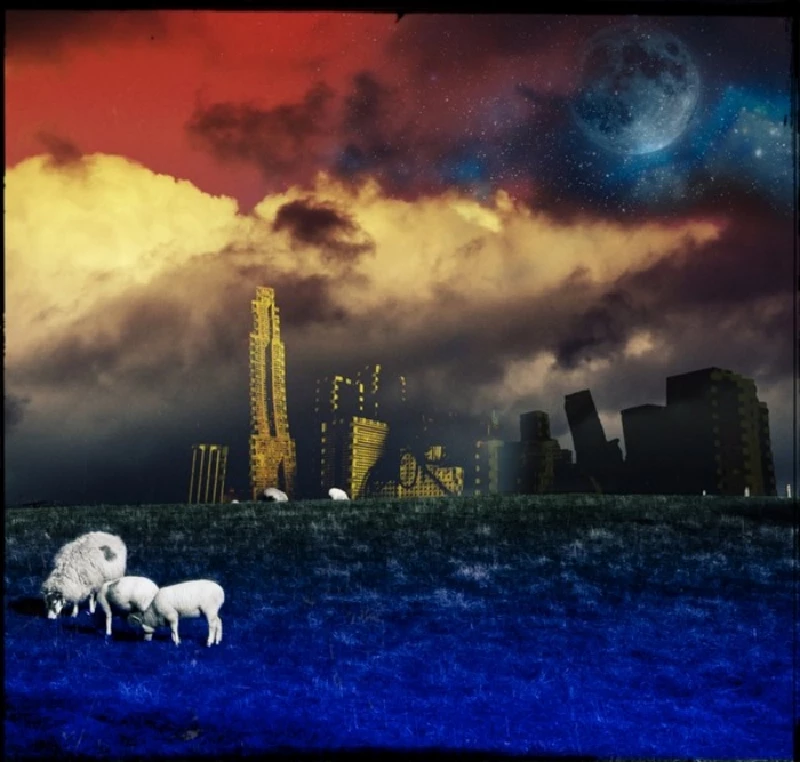
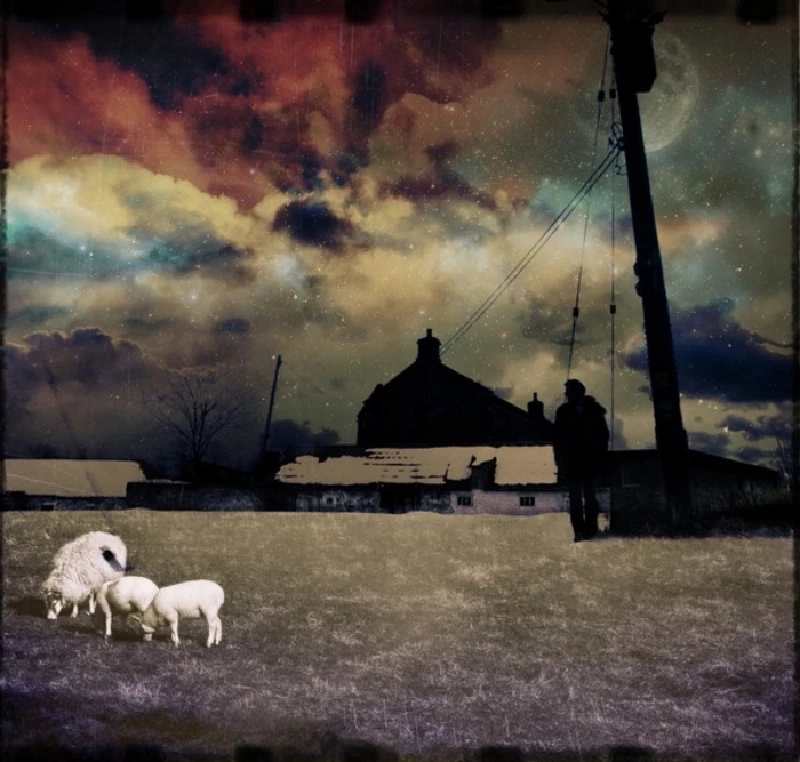

interviews |
|
Interview (2019) |
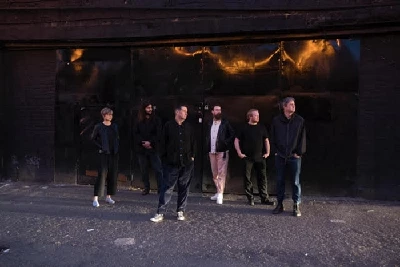
|
| In our fifth interview with them, John Clarkson talks to Johny Brown, Inga Tillere and James Stephen Finn from London-based alternative/indie rock band the Band of Holy Joy about their remarkable latest album, ‘Neon Primitives’. |
| Interview (2018) |
| Interview (2014) |
| Interview (2012) |
live reviews |
|
Tiger Lounge, Manchester, 27/9/2014 |
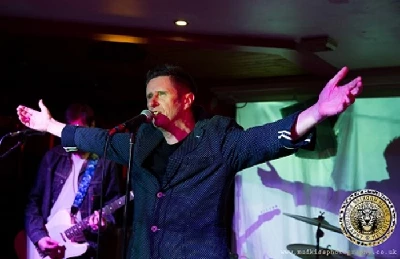
|
| Bill Seagrave watches the Band of Holy Joy play an atmospheric and inventive set at the Tiger Lounge in Manchester |
features |
|
(With Moon Under Water and Dream Maps), Water Rats, London, 17/1/2020 (2019) |
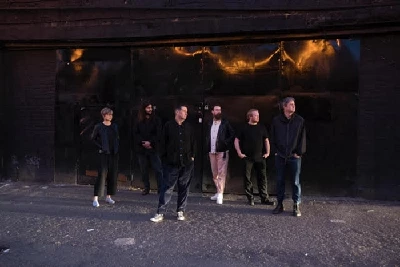
|
| We profile our next London Pennyblackmusic Bands' night which will take place with The Band of Holy Joy, Moon Under Water and Dream Maps at the Water Rats on the 17th January, 2020. |
| (With the Cathode Ray), Wee Red Bar, Edinburgh, 10/12/2017 (2017) |
| (With the Bitter Springs and Idiot Son), Macbeth, London, 9/1/2015 (2015) |
reviews |
|
Brutalism Begins at Home (2017) |
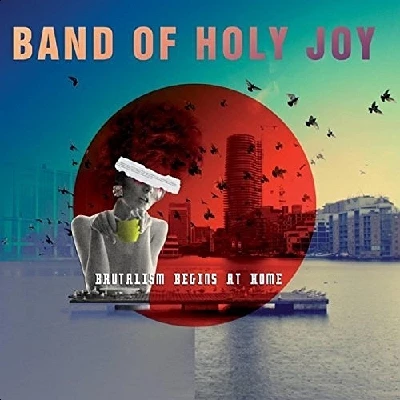
|
| Appealing new EP from London-based alternative rock the Band of Holy Joy which has been released on ten inch vinyl and digitally |
| A Plain Cookerybook for the Working Classes (2016) |
| An Atlas of Spatial Practice (2016) |
| Land of Holy Joy (2014) |
| A Place Called Home (2014) |
| City of Tales (Vol. 1 and 2) (2013) |
most viewed articles
current edition
Spear Of Destiny - InterviewRobert Forster - Interview
Fiona Hutchings - Interview
When Rivers Meet - Waterfront, Norwich, 29/5/2025
Carl Ewens - David Bowie 1964 to 1982 On Track: Every Album, Every Song
Brian Wilson - Ten Songs That Made Me Love...
Chris Wade - Interview
Pistol Daisys - Waterfront, Norwich, 29/5/2025
Credits - ARC, Liverpool, 17/5.2025
Gary Numan - Berserker
previous editions
Heavenly - P.U.N.K. Girl EPBoomtown Rats - Ten Songs That Made Me Love....
Barrie Barlow - Interview
Manic Street Preachers - (Gig of a Lifetime) Millennium Stadium, Cardiff, December 1999
Oasis - Oasis, Earl's Court, London, 1995
Dwina Gibb - Interview
Pixies - Ten Songs That Made Me Love...
David Paton - Magic: The David Paton Story
Chuck Prophet - Ten Songs That Made Me Love...
Sound - Interview with Bi Marshall Part 1
most viewed reviews
current edition
Peter Doolan - I Am a Tree Rooted to the Spot and a Snake Moves Around Me,in a CircleGarbage - Let All That We Imagine Be The Light
Vinny Peculiar - Things Too Long Left Unsaid
Little Simz - Lotus
John McKay - Sixes and #Sevens
Suzanne Vega - Flying With Angels
HAIM - I Quit
Morcheeba - Escape The Chaos
Vultures - Liz Kershaw Session 16.06.88
Billy Nomates - Metalhorse
related articles |
|
Band of Holy Joy/Cathode Ray: Feature (2016 |
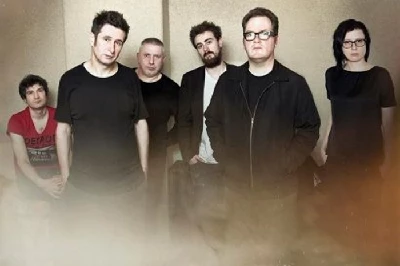
|
| Pennyblackmusic presents three acts from the Edinburgh-based label – The Band of Holy Joy, The Cathode Ray and Roy Moller – at the Sebright Arms on April 15th |
| Morton Valence: Interview (2014) |
Pennyblackmusic Regular Contributors
Adrian Janes
Amanda J. Window
Andrew Twambley
Anthony Dhanendran
Benjamin Howarth
Cila Warncke
Daniel Cressey
Darren Aston
Dastardly
Dave Goodwin
Denzil Watson
Dominic B. Simpson
Eoghan Lyng
Fiona Hutchings
Harry Sherriff
Helen Tipping
Jamie Rowland
John Clarkson
Julie Cruickshank
Kimberly Bright
Lisa Torem
Maarten Schiethart